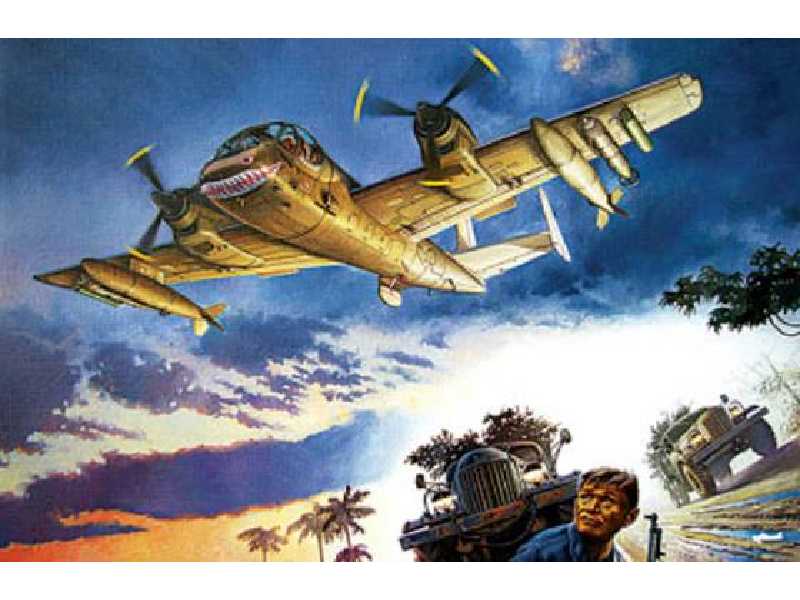- Reduced price




Paints and Glue are not included with any kit unless stated otherwise!
Versions:
At the prototype stage, the OV-1 Mohawk was intended to be multipurpose,
and surveillance was one of the prime tasks for a machine of this
category. The OV-1B which was equipped with SLAR radar would carry
out the functions of radio electronic reconnaissance. However,
at that time the U.S. Army conceived a requirement for a reconnaissance
plane which could conduct direct infra-red surveillance in the
zone of operations. The OV-1 Mohawk was outstandingly suited to
this role, therefore the decision was made not to build a new
prototype, and instead the new equipment was installed in a production
OV-1A.
The infra-red equipment consisted of the UAS-4 heat-sensitive
sensor and a data transmitter mounted in special containers. A
panoramic KA-60 camera was also mounted in the nose which could
scan a 180 degree sector in front of the plane. The Red Haze infra-red
imaging equipment was very sensitive to all kinds of thermal signature
on the ground, be they lights in camouflaged military camps, working
vehicle engines, all kinds of armor and so forth. In the environment
of dense vegetation which covered most of the territory of Vietnam,
where the war had already begun, this feature of the OV-1C Mohawk
(as the new variant was now officially known) appeared to be especially
useful.
The first OV-1C machines had short wings, just as had the OV-1A
version, and also air brakes. Later, longer wings were fitted
to the OV-1C similar to those of the OV-1B reconnaissance plane,
and the air brakes were deleted. This OV-1 Mohawk variant readily
stood out among all the other versions of the 'C' with special
containers over the wings near the fuselage. These contained special
flares of the A4 or B6 type, with 54 in each of the two dispensers.
The flares were fired during night photoreconnaissance missions
when the infra-red equipment detected thermal signatures. The
flares illuminated all around the aircraft which is why these
photoreconnaissance missions produced better quality results.
But the use of this equipment was accompanied by numerous problems
and consequently in 1966 it was decided to remove it. Instead
the special strobe lighting LS-59 unit was mounted under the wing,
which was powered by means of a small wind-driven generator and
lit up the lower hemisphere with powerful lamps through special
windows in the container.
The OV-1C Mohawk was operated together with the OV-A and the OV-1B
by the U.S. Army during the war in Vietnam; one of the earliest
deliveries was received by the 73rd Special Aviation Group. In
the course of operations the infra-red equipment was replaced
by a new and even more sensitive one - the AAS-14 system could
detect single gun shots or thermal emissions from recently stopped
motor vehicle engines. In 1968 during the special SEAMORE Project
some of the OV-1C Mohawk aircraft were fitted with highly classified
reconnaissance equipment of unknown specification - the details
of this activity of the OV-1C over the territory of Vietnam is
still a military secret.
After the end of the Vietnam campaign the OV-1C Mohawks together
with other military vehicles were returned to the USA. Some of
them were upgraded to the more modern OV-1D standard, thus entirely
changing the reconnaissance equipment; some were transferred to
training departments; and a small number of the 133 aircraft of
this variant were transferred to the Customs Service - their OV-1C
basically carried out surveillance of the cross-border narcotics
traffic. During the Quick Look I program two machines were modified
to the RV-1C standard, but the project did not progress beyond
experimenting with the newest radio-electronic technologies.
Manufacture of the OV-1C Mohawk stopped in 1967. In the circumstances
of the Vietnam campaign it played an uncommonly important role,
supporting the Army and seeking out concentrations of the opponent's
forces in the theater of operations and beyond its borders. However,
later on the need for this kind of aircraft greatly decreased,
as radio electronic reconnaissance technology became even more
sophisticated. The OV-1C Mohawk endures in aviation history as
one of the most effective reconnaissance planes of its era.
| Performances | |
| Wingspan | 14.6m |
| Total length | 12,5 m |
| Empty weight | 4704 kg |
| Take-off weight | 5915 kg |
| Max speed | 496km/h |
| Service ceiling normal | 9150 m |
| Service ceiling with one engine | 4256 m |
| Flight range normal | 710 km |
| Flight range with auxiliary fuel tanks | 2140 km |
| Take-off run | from 15 to 290 m |
| Landing run | from 15 to 240 m |
| Engines | 2xLycoming T-53-L-7 |
| Special equipment | 2xcontainers for 2.75 - inch missiles having from 7 to 19 cartridges each; LS-59A strobe pods. |
No carriers available for this product.
The above shipping costs are for 1 item only.
You will see the final shipping costs when you place your order.
Manufacturer RODEN Oleksy Tykhogo 93 03067 Kijów Ukraine roden@roden.eu
Responsible person International Business Group Spółka Jawna Piotr Andrzejewski, Lidia Andrzejewska, Adam Andrzejewski Benedykta Hertza 2 04-603 Warszawa Poland ibgsc@ibg.com.pl +48228159150
@COMMENT_COMMENT@
@COMMENT_COMMENT@

@COMMENT_TITLE@
@COMMENT_COMMENT@